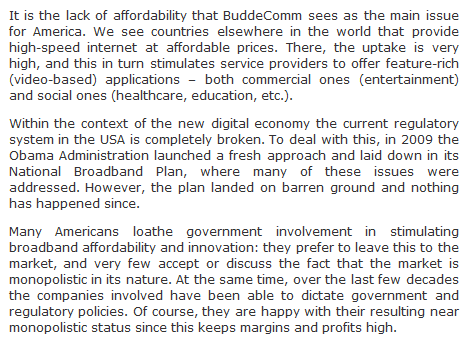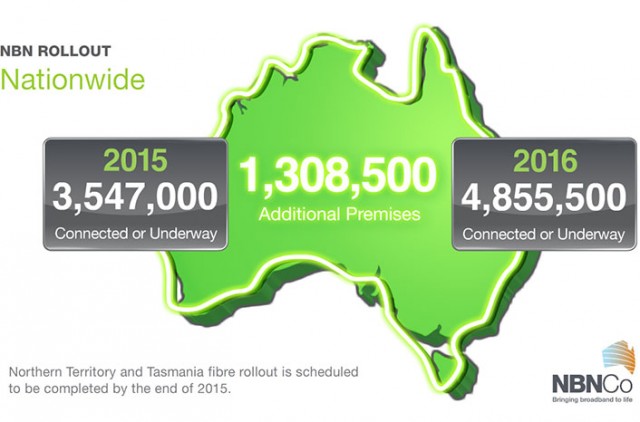 Attention broadband planners: Although broadband deployment strategies differ around the world, a new report decisively concludes there is only one network technology proven to meet the demands of broadband users both today and tomorrow: a national fiber optic network.
Attention broadband planners: Although broadband deployment strategies differ around the world, a new report decisively concludes there is only one network technology proven to meet the demands of broadband users both today and tomorrow: a national fiber optic network.
BuddeComm’s new report, “Global Broadband – Fibre is the Infrastructure Required for the Future,” looked at every technology from variations of DSL, cable broadband, satellite, and wireless and found only fiber optics capable of handling the capacity of data and applications that will be required to run cities and countries from today onwards.
The report found that fiber optic deployment faced a range of challenges, despite its obvious technological advantages. Political obstacles are among the biggest roadblocks facing fiber networks. A combination of concerns about the cost of wiring service to procrastination has held back many national broadband improvement projects, including those in Australia and New Zealand. Incumbent commercial providers in North America have also actively attempted to block public fiber networks to protect their own commercial interests.

BuddeComm concludes America’s biggest broadband problems come as a result of incumbent providers exercising undue market power and influence over elected officials to protect their commercial interests at the price of the public good.
The report concludes that decisive political leadership is essential to overcome many of the artificial obstacles which slow down or stop fiber broadband deployments.
“One can argue endlessly about what technologies should be applied and at what cost, but we believe that all signs point to Fiber-to-the-Home (FTTH) networks as the best future-proof solution,” the report concludes. “One can debate about whether it is needed in five, ten or fifteen years – and again that depends on some of the differences between countries – but in the end FTTH is the best final solution for all urban and many regional premises.”
The 21st century digital economy is powered by robust broadband, and growing demands for faster speeds are coming from the healthcare, energy, media and retail sectors. Healthcare uses include file transfers of high-definition medical imagery and teleconferencing. Smart Grid technology is being deployed by many power companies to develop more efficient means of distributing and conserving energy. Media and mass entertainment providers are moving to high bandwidth online video, and the retail economy markets products and services over modern broadband networks.
The implications for the global economy are enormous. More than 120 countries have formal broadband policies and many consider high-speed Internet access a national priority. In the last century, North America and western Europe were considered the dominant economic players, in part because they established and maintained infrastructure to support their manufacturing and service economies. But many of these countries are falling far behind in the 21st century digital economy, where countries like Japan and Korea, parts of eastern Europe, the Baltic States, and Scandinavia are taking the lead in infrastructure deployment.
“Broadband infrastructure is perceived by all to be critical for the development of the digital economy, healthcare, education, e-government and so on,” the report notes. “From a financial and investment point of view broadband infrastructure should be treated as utility infrastructure.”
The interests of the private sector are not always aligned with the public interest, particularly when it comes to spending capital on upgrading network infrastructure. The report recommends that governments step in and build a public fiber highway system on which all providers can offer services.
“A National Broadband Network (NBN) should be based upon an open network as this makes it possible to offer the basic infrastructure on a utility basis to content and service providers,” the report concludes.
The governments of Australia, New Zealand, Israel, and others are already moving in that direction, setting up broadband authorities to build fiber infrastructure dismissed as too expensive or unnecessary by commercial providers who answer first to financial markets, shareholders, and private banks.
Under most NBN plans, providers get access to the fiber network at wholesale rates and help recoup its cost.

Australia’s National Broadband Network is on the way.
Where politicians answer to the whims of the private sector before considering the public good, the report finds:
- Private cable companies, particularly in North America, will continue to support and incrementally upgrade their HFC networks, but new cable operators are more likely to deploy fiber at the outset, not coaxial copper cable. Network costs, efficiencies, and reliability are all in fiber’s favor. In Europe, cable broadband is regularly losing market share to faster fiber technology. The share of all broadband subscribers held by HFC networks across Europe fell from 26% in 2002 to about 11% by mid-2013;
- Private telephone companies that do not face robust competition will continue to rely on their existing DSL networks. In cities and larger towns, expect phone companies to eventually upgrade to VDSL fiber-to-the-neighborhood (and its variants) in the largest markets with the most competition. Rural areas will continue to receive less robust DSL service, particularly where no cable competitor provides service;
- Rural areas may receive fixed wireless or satellite broadband service, but this is not a solution for more populated areas.
Although the global economic downturn stalled many fiber network deployments and suppressed demand, the report finds broadband usage and demand for faster speeds are quickly accelerating. Some other highlights:
- Asia continues to be the leader in fiber optic deployment;
- Sufficient customer demand to make the investment in fiber worthwhile is increasingly likely once fiber service becomes widely available in countries like the Netherlands, China, France, Israel, Switzerland, Norway and Sweden;
- International connectivity in Africa remains a challenge, but fiber bandwidth is expected to more than double by 2014;
- The Middle East will see rapid growth in fiber broadband once international capacity constraints are eased.
Obtaining a copy of the full BuddeComm report is prohibitively expensive for consumers, priced at $995.


 Subscribe
Subscribe
We just need to implement a single measure: a government granted RoW or frequency (a public good) requires an open access/interconnect model in layer 1. This needs to be applied to all providers, which was not the case in the Telecom Act. As a quid pro quo, local regulators and landlords cannot get in the way of citizens’ and tenants’ rights to access networks. Some level of aesthetics and measures to avoid inconvenience and harm need to be established. The market can and will do the rest as we saw with competitive voice, data and wireless in the 1980-90s. It… Read more »